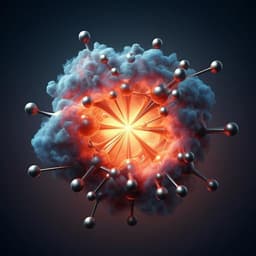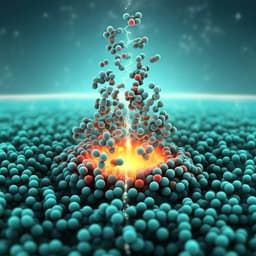
Engineering and Technology
Enhanced degradation and recycling of reactive dye wastewater using cobalt loaded MXene catalysts
D. Shu, X. Zhang, et al.
This groundbreaking research by Dawu Shu, Xinqi Zhang, Bo Han, Wanxin Li, Bingxin Wang, and Chengshu Xu presents an innovative approach to treating reactive dye wastewater via cobalt-loaded MXene catalysts and peroxymonosulfate. Achieving 97.1% degradation efficiency in just 36 minutes, this work paves the way for sustainable practices in textile dyeing!
~3 min • Beginner • English
Introduction
The rapid growth of the printing and dyeing industry has led to significant discharges of persistent organic dyes into water bodies, posing threats to human health and ecosystems. Reactive dyes, widely used in textiles, are structurally complex and difficult to degrade, limiting the efficacy of conventional wastewater treatments. Advanced oxidation processes (AOPs), especially sulfate radical-based systems using peroxymonosulfate (PMS), offer effective degradation via reactive oxygen species (ROS). Transition-metal activation of PMS, particularly by cobalt, efficiently generates SO₄•⁻ and can outperform Fenton chemistry near neutral pH with fewer reagents. However, homogeneous Co(II) catalysts face challenges including recyclability and metal leaching. MXenes, two-dimensional transition metal carbides/nitrides with abundant surface functional groups and defect sites, can anchor and reduce metal ions, enabling construction of heterogeneous Co-loaded MXene (Co@MXene) catalysts that synergistically activate PMS while offering low toxicity and potential environmental applicability. This study prepares Co@MXene via molten salt synthesis and evaluates its performance and mechanism for degrading reactive dyes, along with catalyst recyclability and reuse of treated effluent for dyeing.
Literature Review
Prior work has established multiple PMS activation pathways—thermal, alkaline, electrochemical, UV/photochemical, sonochemical, transition-metal, and carbonaceous materials—producing SO₄•⁻ and •OH for organic pollutant degradation. Co-based PMS activation has shown superior performance to classical Fenton at neutral pH with reduced reagent consumption, though homogeneous Co systems suffer from low recyclability and potential metal leakage. MXenes, obtained by selective etching of MAX phases, possess surface terminations (-O, -OH, -F) conducive to metal ion adsorption/reduction and exhibit defect sites that enhance anchoring, enabling composite catalysts with transition metals or oxides to synergistically activate PMS. Reports also indicate low toxicity of MXenes in biomedical contexts, supporting environmental remediation potential. Recent studies on single-atom catalysts on MXenes and metal-free PMS activation highlight both radical and nonradical (e.g., ¹O₂) pathways, suggesting that singlet oxygen can dominate under certain configurations, including MXene-based systems.
Methodology
Materials: Ti₂AlN MAX (400 mesh), NaOH, NaCl, Na₂CO₃, HCl (36%), EtOH, MeOH, tert-butanol (TBA), furfuryl alcohol (FFA) from Shanghai Macklin; PMS (2KHSO5·KHSO4·K₂SO₄) and CoCl₂ from Aladdin; reactive dyes RR218, RR195, RB5 from Jiangsu Shenxin.
Preparation of Co@MXene: Ti₂AlN powder and CoCl₂ were ground at a molar ratio 1:2, transferred to a ceramic boat, and heated at 1000 °C for 7 h (muffle furnace). After cooling, the powder was soaked in 3 M HCl (200 mL, 4 h) to remove Co particles, centrifuged at 3500 rpm for 15 min, washed to supernatant pH > 6.5, and freeze-dried at −20 °C for 48 h to obtain Co@MXene.
Degradation experiments: 100 mL of 0.06 g/L dye solution was treated in a thermostatic water bath at 25 °C. PMS (1–5 g/L) and Co@MXene (0.1–2.0 g/L) were varied; initial pH adjusted as needed (3, 7, 10). Absorbance at dye λmax (RR195 542 nm, RR218 547 nm, RB5 604 nm) was monitored. After reaction, the system was filtered (0.22 µm), solids recovered, washed (centrifuge 4500 rpm, 10 min) to neutral pH, and vacuum-dried 24 h for cycling tests.
Radical quenching: MeOH quenched SO₄•⁻ and •OH; TBA quenched •OH; FFA quenched ¹O₂. Control runs had no scavengers. Contributions were calculated as R_ROS = (k − k_ROS)/k using pseudo-first-order rate constants.
Reuse of treated wastewater for dyeing: Cotton fabric (2.0 g) was dyed in 60 mL treated wastewater or deionized water (bath ratio 30:1) with 0.5% o.w.f RR195. Process: 25 °C, 15 min; add 60 g/L NaCl, 15 min; raise to 60 °C for 10 min; add 20 g/L Na₂CO₃; fix at 60 °C for 30 min. The dye bath residue was degraded and the treated wastewater reused for up to 10 dyeing cycles.
Evaluations: Degradation percentage S% = (1 − At/A0)×100%. Pseudo-first-order kinetics determined from ln(At/A0) = −kobs t. Dyeing exhaustion E% = (A0 − At)/A0×100%. Fixation F% = (A0 − A1 − A2)/A0×100%. Color parameters (L*, a*, b*, K/S) by Color i5; color fastness tests per GB/T 3921-2020. Characterizations: SEM/EDS, XRD, XPS, FTIR.
Key Findings
- Co@MXene + PMS exhibited synergistic degradation of reactive dyes; PMS or Co@MXene alone gave only 1.64% and 24.5% degradation at 36 min (25 °C, pH 7), while the combined system achieved 97.1% for RR195 under 1.0 g/L Co@MXene and 3 g/L PMS.
- Catalyst loading: Increasing Co@MXene from 0.1 to 1.0 g/L raised k from 0.033 to 0.0894 min⁻¹; further increase to 2.0 g/L did not improve k (remained ~0.0894 min⁻¹), indicating an optimal catalyst concentration of 1.0 g/L for the given dye and PMS levels.
- PMS concentration: At 12 min, degradation at 1, 2, 3, 4, and 5 g/L PMS was 68.8%, 64.1%, 67.1%, 82.1%, and 77.2%, respectively. PMS at 4 g/L yielded the fastest rate in the mid-stage, but final degradation after sufficient time was similar across 1–5 g/L; 3 g/L was selected balancing rate and efficiency.
- pH effect: k values at pH 3, 7, and 10 were 0.1068, 0.0894, and 0.1172 min⁻¹, respectively. Alkaline conditions accelerated early degradation (to 89.48% by 8 min at pH 10), but final degradation exceeded 97.1% at all pH levels (3–10).
- Temperature: At 5 min, degradation increased with temperature: 39.51% (25 °C), 66.57% (40 °C), 92.08% (60 °C). Activation energy for RR195 degradation by Co@MXene-activated PMS was 40.31 kJ/mol (R² = 0.9469).
- Salinity: Adding NaCl (0–25 g/L) accelerated degradation rates without altering final removal. k increased from 0.0894 min⁻¹ (0 g/L) to 0.4984 min⁻¹ (20 g/L; 5.57× faster); higher than 20 g/L did not further increase k. With 5 g/L NaCl, 98.93% degradation was reached in 12 min (vs 97.12% at 36 min without NaCl).
- Dye scope: Under 3 g/L PMS, 1.0 g/L Co@MXene, pH 7, 25 °C, 36 min, final degradation for RR218, RR195, RB5 was 97.02%, 97.12%, 97.33%, with k = 0.0894, 0.0905, and 0.0821 min⁻¹, respectively, showing broad applicability across different reactive dye chemistries.
- Mechanism and active species: Scavenger tests reduced final degradation to 84.34% (MeOH), 40.2% (TBA), and 17.2% (FFA) and reduced k to 0.0587, 0.0080, and 0.0022 min⁻¹, indicating participation of •OH, SO₄•⁻, and dominant ¹O₂. Estimated contributions to rate inhibition: ¹O₂ 66.71%, SO₄•⁻ + ¹O₂ 8.94%, •OH + SO₄•⁻ 2.46%. XPS showed Co in multiple oxidation states (Co⁰/Co²⁺/Co³⁺) with evidence of Co³⁺ reduction to Co²⁺ during use, supporting a Co²⁺/Co³⁺ redox cycle.
- Recyclability: After 10 catalytic cycles, residual dye increased from 2.88% to 6.47% (degradation ~97.12% to 93.53%); k decreased from 0.0973 to 0.0744 min⁻¹, confirming good reusability.
- Reuse in dyeing: Using treated wastewater as dye liquor improved dye uptake rates by 1.29–7.34% vs deionized water at the same times; colorimetric changes indicated slightly darker, more reddish shades with higher K/S, and comparable rubbing and washing fastness across 0, 1, 5, and 10 cycles.
Discussion
The study demonstrates that Co@MXene synthesized by molten salt loading effectively activates PMS to degrade reactive dyes rapidly and robustly across varying conditions of pH, temperature, and salinity. The heterogeneous configuration addresses recyclability issues of homogeneous cobalt systems while maintaining high activity. Kinetic analyses and low activation energy (40.31 kJ/mol) indicate an energetically favorable process, with alkaline conditions and elevated temperatures enhancing the reaction rate. The substantial rate enhancement by NaCl, common in textile effluents, highlights the system’s practical relevance for saline wastewater. Radical quenching and XPS evidence support a mechanism involving a synergistic combination of •OH, SO₄•⁻, and predominantly ¹O₂, facilitated by a Co²⁺/Co³⁺ redox cycle and MXene’s defect-rich surface that promotes PMS activation and nonradical pathways. Applicability to multiple reactive dye types with similar final removal underscores generality. The catalyst’s sustained performance over 10 reuse cycles and the successful reuse of treated dyeing wastewater for subsequent dyeing—with improved exhaustion and maintained fastness—illustrate an integrated approach to both degradation and resource recovery, addressing environmental remediation and circular processing in the dyeing industry.
Conclusion
Co@MXene prepared via a molten salt method is an efficient heterogeneous catalyst for PMS activation, achieving up to 97.1% removal of reactive dyes (e.g., RR195) within 36 min at ambient conditions and neutral pH, with strong tolerance to salinity and broad dye applicability. The degradation mechanism entails synergistic radical (SO₄•⁻, •OH) and nonradical (¹O₂-dominated) pathways supported by a Co²⁺/Co³⁺ redox cycle on MXene. The catalyst retains high activity over at least 10 cycles (93.5% removal) and enables reuse of the treated effluent for dyeing with enhanced uptake and comparable fastness. These findings provide a feasible strategy for efficient treatment and recycling in textile wastewater management.
Potential future work includes evaluating performance on complex real industrial effluents, long-term stability and leaching assessments, optimization under continuous-flow conditions, and expanding contaminant scope beyond dyes.
Limitations
Experiments were conducted primarily on simulated dye solutions at a fixed dye concentration, with limited contaminant scope and matrix complexity. Metal leaching data were not reported. Mineralization metrics (e.g., TOC) and byproduct toxicity were not discussed. Scaling to continuous or large-scale operations and long-term stability beyond 10 cycles were not evaluated.
Related Publications
Explore these studies to deepen your understanding of the subject.







